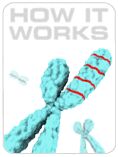人乳腺癌miRNA PCR芯片 Breast Cancer qBiomarker Copy Number PCR Array

人乳腺癌miRNA PCR芯片 Breast Cancer qBiomarker Copy Number PCR Array
“英拜为您实验加速” 技术服务网址:http://www.yingbio.com/ 服务热线:400-696-6643、 18019265738 邮箱:daihp@yingbio.com 、 huizhang1228@foxmail.com Breast Cancer qBiomarker Copy Number PCR Array 乳腺癌qBiomarker拷贝数PCR芯片
乳腺癌qBiomarker拷贝数PCR芯片用于研究在人类乳腺肿瘤中已报道发生频繁突变的23个基因的拷贝数。乳腺癌细胞的DNA拷贝数改变预后的影响,例如,HER2扩增或超表达定义乳腺癌患者HER2 +的子群,是不良结果的预后分子标记和响应anti-HER2靶向疗法的预测分子标记。该芯片上的基因编码受体,激酶,磷酸酶,和调节细胞周期、生长因子信号传导,细胞粘附等过程的转录因子。芯片基于主要文献和公共数据库,选择最频繁扩增或缺失且与致癌途径和乳腺癌生物学相关的基因。这个芯片可能成为帮助乳腺癌样本进行基因型分类并验证乳腺癌表型生物标记的有效工具。这个芯片可以使每个基因在每个样本中有四个重复,同时包含一个稳定的多拷贝参考实验,通过适当的DNA插入标准化精确检测拷贝数。简单的产品模式和操作程序让任何一个具备实时定量PCR仪的实验室都可进行常规可靠的拷贝数检测。 qBiomarker拷贝数PCR芯片用于分子生物学应用。本产品不用于疾病的诊断、预防和治疗。 ER+/PR+, HER2:CCND1. Gain in ER+ Tumors:AURKA. HER2+:ERBB2. Inflammatory Breast Cancer:ERBB2, MTDH, MYC, PTK2, RB1. Lapatinib Sensitivity:CDKN2A, EGFR, ERBB2. AKT & PI-3-Kinase Signaling:AKT1, PPAPDC1B, PTEN. Apoptosis:BCL2L1, MTDH. Cell Adhesion & Cytoskeleton:CSMD1, PAK1, PTK2. Cell Cycle:AURKA, BCL2L1, CCND1, CDK4, CDKN2A, RB1. DNA Repair:C11orf30 (EMSY), TOP2A. Drug Metabolism:BCHE. NFKB Signaling:MTDH. Receptor Tyrosine Kinases:EGFR, ERBB2, FGFR1, FGFR2. Transcription Factors and Co-Factors:MTDH, MYC, NCOA3, RB1, TFDP1. 工作原理: The Copy Number PCR array is a set of optimized real-time PCR primer assays on 96-well, 100-tube or 384-well plates for measuring changes in copy number. The PCR array performs copy number analysis with real-time PCR sensitivity and the multi-loci profiling capability of a microarray. Simply mix the genomic DNA sample with the appropriate ready-to-use PCR master mix, aliquot equal volumes to each well of the same plate, and then run the real-time PCR cycling program. (Download user manual)
The procedure involves isolating genomic DNA (QIAGEN QIAamp DNA Mini Kit or FFPE Tissue Kit is recommended), qPCR detection on qBiomarker Copy Number PCR Arrays or Assays, and data analysis (using the qBiomarker Copy Number Data Analysis). An optional DNA sample quality control step immediately before the detection array or assay setup allows the user to qualify the DNA samples. Why qBiomarker Copy Number Arrays?
Layout and Controls: The PCR Arrays are available in both 96-, 384-well plates and 100-well discs and are used to measure the copy number of 23 or 95 genes related to a disease state or pathway. Each gene/locus-specific assay is repeated in technical quadruplicate as indicated in the figure above. As an example, the first gene in the array is measured in wells A1, C1, E1 and G1. The qBiomarker Multicopy Reference Assay (MRef) is used to normalize the data for differences in the amounts of genomic DNA. The Multicopy Reference Assay is shown in purple in the above figure in wells B12, D12, F12, and H12. You can easily perform a Copy Number PCR Array experiment in your own laboratory, or send your samples to us and take advantage of our PCR Array Services. *: when using qBiomarker SYBR® Green Mastermix. Performance Data: qBiomarker Multicopy Reference Assay
RNaseP gene is not suitable as a normalizer of sample input in cancer cell line DNA samples. The absolute average copy numbers of RNaseP per normal genome copy amount of DNA were determined in two breast cancer cell line (SKBR3 and MCF7) genomic DNAs with the delta delta Ct method, using QIAGEN multi-copy reference assay as the normalization control of DNA input. The absolute copy number of RNaseP per normal genome in the genomic DNA is assumed to be 2. Universal Nature of Multicopy Reference Assay
Stable Performance of the Multicopy Reference (MRef) Assay in 129 DNAs from 9 Major Human Populations. The qBiomarker multi-copy reference assay (MRef) and a qBiomarker copy number assay for RB1 were tested against DNAs from 129 healthy individuals from 9 major ethnic populations. Each assay and DNA sample combination was run in quadruple reactions. Delta CT between the average CT of the MRef assay and the RB1 assay was calculated for each individual DNA. The average delta Ct for samples within each ethnic population is plotted. Error bars show the standard deviation of the delta CT within each ethnic population. The RB1 gene is assumed to be present at 2 copies in all healthy individual DNAs. Application Data Aneuploidy Study
qBiomarker Copy Number Assays accurately identify aneuploidy. qBiomarker Copy Number Assays designed to target AR and MECP2 were tested against 4 cell line DNAs containing 1 copy (XY, Coriell NA13619), 2 copies (XX, Coriell NA01921), 3 copies (XXX, Coriell NA03623) and 4 copies (XXXX, Coriell NA11226) of X-chromosome. Chromosomal aberrations had been previously identified by cytogenetic methods. A control assay, targeting a stable, multi-copy region in the human genome, was used to normalize the amount of DNA input. ΔΔCT method was used to calculate the gene copy number, using XX (Coriell NA01921) as a 2-copy reference. Each assay was tested against each sample in quadruple replicate reactions, and a t-test was performed. |
















